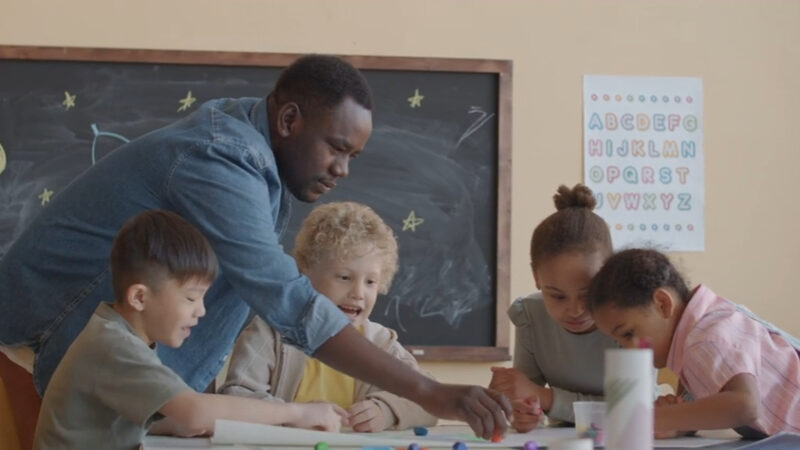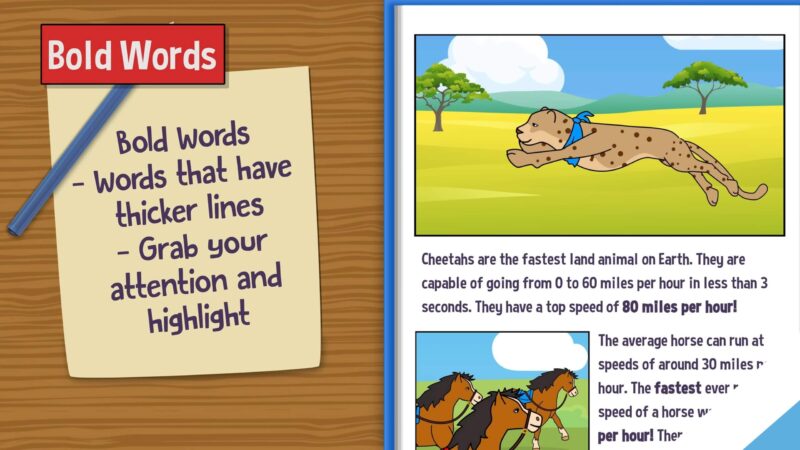Imagine reading a book filled with nothing but paragraph after paragraph of text. Now, picture a book with titles, subtitles, bullet points, images, and captions. Which one seems more inviting and easier to understand?
The difference lies in the text features. For children, learning about text features is like gaining a superpower in their reading journey, allowing them to navigate through texts with ease and confidence.
Key Takeaways
- Text features are the parts of a book or article that help organize the content, making it easier for readers to understand and retain information, such as headings, bullet points, captions, and glossaries.
- To teach kids these, start with a guided discovery approach, use real-life examples, and create a text feature hunt.
- Make use of anchor charts, incorporate technology, practice with worksheets and graphic organizers, model reading aloud, and encourage reflection.
What are Text Features?
Text features are various elements present in nonfiction and informational texts that help readers understand the content better. They include:
| Text Feature | Description |
|---|---|
| Headings and Subheadings | Signal the start of a new topic or section. |
| Tables of Contents | Provide an overview of the topics covered and their page numbers. |
| Indexes | List the topics in alphabetical order with page numbers. |
| Glossaries | Explain the definitions of terms used in the text. |
| Bold and Italicized Text | Emphasize important words or phrases. |
| Bullet Points and Numbered Lists | Organize information in an easy-to-digest format. |
| Captions | Describe what is happening in pictures or diagrams. |
| Photographs and Illustrations | Visual representations of the content. |
| Graphs and Charts | Present data in a visual format. |
| Sidebars | Offer additional information related to the main text. |
Each of these features plays a crucial role in enhancing a child’s comprehension by breaking down information into manageable parts and providing visual cues to support understanding.
How to Teach Them to Kids?
Teaching these elements to children involves explicit instruction, hands-on activities, and continuous practice. Here are some strategies that work wonders:
1. Start with a Guided Discovery Approach

- Introduce text features through a guided discovery approach.
- Show children a variety of books and articles, asking them to notice and discuss any non-text elements they see.
- This method piques their curiosity and lays a foundational understanding of these elements.
- Encourage questions about why these features are used and how they help the reader.
- Compare texts with and without these features to highlight their importance.
- Use diverse materials to ensure children encounter a wide range of text features.
2. Use Real-Life Examples

- Incorporate magazines, newspapers, and informational books in your lessons.
- Real-life examples make learning relevant and help children see the practical application of these animals.
- Discuss the purpose behind each text feature and how it aids in understanding the content.
- Collect examples from different sources to show variety in how text features are presented.
- Encourage children to bring in their own examples from home to share with the class.
- Analyze these real-life examples together to reinforce learning.
Amidst this exploration, introducing them to a selection of soothing Disney tunes can serve as a delightful way to demonstrate how music and lyrics, much like text features, can paint vivid pictures and tell stories, enriching their learning experience.
3. Create a Text Feature Hunt
- Turn learning into a game by organizing a text feature hunt.
- Provide children with a checklist of text features to find in a selected book or article, rewarding them for each feature they successfully identify.
- This activity encourages active engagement and reinforces their learning.
- Designate specific books or parts of the library for the hunt to make it manageable.
- Offer small prizes or recognition for finding all the features on the checklist.
- Use a variety of texts over time to cover a broad spectrum of features.
4. Make Use of Anchor Charts

- Anchor charts are visual aids that display key information about text features.
- Creating these charts with your students or displaying ready-made ones in the classroom can serve as a constant reminder of what each text feature is and its purpose.
- Update the charts regularly with examples from current lessons or student findings.
- Involve students in creating these charts to enhance their engagement and understanding.
- Place the charts strategically around the classroom for easy reference during reading activities.
- Review the charts periodically as a refresher on the importance of each text feature.
5. Incorporate Technology

- Leverage educational apps and websites that offer interactive activities on text features.
- These digital resources can make learning more engaging for children and accommodate different learning styles.
- Integrate these tools into classroom activities for a hands-on learning experience.
- Use technology to track progress and provide immediate feedback on exercises.
- Encourage children to explore these resources at home with their families.
- Select apps and websites that are age-appropriate and align with your learning objectives.
6. Practice with Worksheets and Graphic Organizers

- Worksheets that focus on identifying and using text features help reinforce learning.
- Graphic organizers, on the other hand, can be used to map out the text features found in a passage, aiding in comprehension.
- Provide a variety of worksheets to cover different elements and complexity levels.
- Use graphic organizers to break down individual texts in detail, emphasizing how each feature contributes to understanding.
- Encourage students to create their own worksheets and organizers as a creative exercise.
- Review completed worksheets and organizers together to discuss findings and clarify any misunderstandings.
7. Model Reading Aloud

- When reading aloud to children, point out and discuss text features as you encounter them.
- This modeling helps children understand how to use these elements to predict and analyze the content.
- Emphasize the connection between these elements and the overall understanding of the text.
- Choose texts with a wide variety of features for read-aloud sessions to cover more ground.
- Ask predictive questions based on the text features to engage students in critical thinking.
- Encourage students to volunteer for read-aloud sessions, guiding them to highlight these elements.
8. Encourage Reflection

- After reading, encourage children to reflect on how text features helped them understand the text.
- This reflection reinforces the value of these elements and encourages their use in future readings.
- Guide students through structured reflection questions or journal prompts.
- Share reflections as a class to learn from each other’s insights.
- Use reflections to assess understanding and inform future instruction.
FAQs
Can text features be found in fiction books?
While these elements are most commonly associated with non-fiction and informational texts, fiction books can also have text features such as chapter titles, illustrations, and sometimes glossaries, which help readers navigate the story.
Are text features only important for young readers?
These elements are essential for readers of all ages, as they aid in comprehension and information retrieval. However, teaching them to young readers builds a foundation for effective reading strategies that benefit lifelong learning.
How can I assess my child’s understanding of text features?
You can assess understanding through activities like the text feature hunt, asking them to explain the purpose of different features, or having them use these elements in their own writing. Observing their ability to navigate texts independently can also provide insights.
Do digital texts have the same text features as printed texts?
Digital texts often have similar, if not additional, text features compared to printed texts. For example, hyperlinks and interactive elements can serve similar purposes as glossaries and indexes in printed texts.
How can I make learning text features more accessible for students with learning disabilities?
Use multi-sensory teaching methods, including visual aids like anchor charts, interactive technology, and hands-on activities. Providing personalized instruction and allowing extra time for practice can also help.
Can understanding text features improve writing skills?
Yes, they can significantly improve writing skills. It helps students organize their writing more effectively, making their work clearer and more engaging for the reader.
Summary
Teaching kids about text features equips them with critical tools for navigating informational texts, enhancing their comprehension, and fostering a love for reading.
By making these elements an integral part of your teaching strategy, you’re not just teaching children how to read better; you’re opening their minds to the rich world of information that surrounds them.
With patience, creativity, and the right approach, you can transform how children interact with texts, making reading a more enjoyable and fruitful experience for them. Always keep in mind the goal is to make these concepts accessible and fun, turning every reading opportunity into an adventure of discovery.
